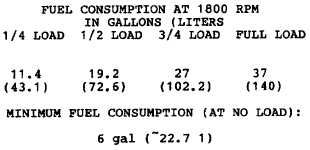TM 5-6115-593-34
NAVFAC P-8-631-34
TO-35C2-3-463-2
Air trapped in the fuel causes erratic performance and
hard starting. For this reason, piping must be
completely sealed against entrance of air and fine dust
or dirt.
17-62. Auxiliary tank fuel filters and sediment drains are
located in the set and are easily accessible to promote
regular and frequent service. Cleanliness of the fuel is
especially important on diesel engines which have easily
clogged, precision fuel injectors, and pumps.
17-63. Black iron pipe or copper tubing must be used
for diesel fuel systems galvanized tanks and piping must
not be used since the diesel fuel and the galvanized
coating react chemically to produce flaking which
quickly clogs filters or causes failure of the fuel pump or
injectors. Flexible lines must be of the type approved
for diesel fuels.
17-64. The auxiliary fuel tank should be vented so that
air and other gases can escape to atmosphere (see
figure 17-16 through 17-18). The vent must, however,
prevent dust, dirt, and moisture from entering the tank.
Where return lines are required, keep the return spaced
at least 12 inches (30.5 cm) away from the pickup or
fuel dip tube if this is not done, air bubbles could be
entrained in the fuel and cause erratic operation. At
least 5 percent of capability should be allowed in a
diesel main tank for expansion of the fuel. Auxiliary fuel
tank capacity can be computed by using table 17-6.
Table 17-6. Fuel Consumption for 500 KW DOD Generator Set
17-65. SET FUEL TANK. The capacity of the fuel tank
is determined by the fuel consumption of the unit and
the continuous operating time necessary. Fuel supply
capacity for generator service is 2 hours under full load
without refueling. All auxiliary tanks must have:
a. A vent line terminating above grade level in a
screened or hooded type vent cap with
unrestricted opening to atmosphere.
b. A fuel fill line terminating above grade level
and fitted with an appropriate cap or
terminating in a fuel filler box with an
appropriate cap and plainly marked for the
fuel utilized.
c.
A fuel supply line connected from the tank to
the electric fuel transfer pump.
d. The tank should be fitted with a foot valve
(permits flow in one direction only) to prevent
loss of transfer pump prime when the
transfer
pump is not in operation.
17-66. The auxiliary fuel oil transfer pump is an internal
part of the generator set and has the capacity to fill the
fuel tank in one hour when pumping fuel at a
temperature of 25°F (-31.7°C). Additionally, the pump is
capable of lifting fuel 10 feet (3 m) and provides
sufficient pressure to supply fuel through the filtration
system under all possible viscosities of the fuel.
17-20

